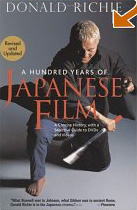A Hundred Years of Japanese Film |
(Book) |
by Donald Richie
foreword by Paul Schrader
cover photo: Beat Takeshi as Zatoichi

by Donald Richie |  |
Donald Richie has long been recognized as the English-language authority on Japanese film. In keeping with that, this book is an exhaustive, meticulously researched and footnoted guide to the subject. Donald Richie knows more Japanese directors than you possibly can, and he writes comprehensively about them in this book.
The book's basic orgnization is chronological, but within that structure he examines each director (or occasionally studio) in turn. Coverage is complete, so virtually everyone from the heyday of Japanese cinema (the 30s through the 50s) gets a mention, but the long sections of the book reveal the author's deepest interests: Yasujiro Ozu, Akira Kurosawa, and Mizoguchi Kenji. While Kurosawa is well-known in the U.S., the small stories of Ozu and stately pacing of Mizoguchi are still new to many westerners.
Sadly, as someone who lives in Japan currently, I can attest they are mysteries to most contemporary Japanese as well. Even though I work in the animation industry here, virtually none of my colleagues have an interest in or knowledge of the Japanese film industry. Kurosawa movies are things that were seen on TV, as children; Ozu or Mizoguchi are barely even known. More generally, the animation industry here seems completely cut off from the live action industry; a very different attitude than I found in the American animation industry, where animation and live action are regarding as two crafts pursuing a similar end. Perhaps it's because of the special effects industry, which in America or England bridges the two. In any case, I am more familiar with the ouevre of Kurosawa than most Japanese I work with.
Returning to the book, it's essential reading for anyone with an interest in Japanese film, and in addition it uses a fascinating organizing principle in examing the many films: they are all placed on an axis from representational to presentational.
Richie observes that all entertainment falls somewhere on this axis. Photography and its filmic cousin documentary are perhaps the purest forms of representational media: While editing always exercises an influence, the aim of these media (outside of the Michael Moores) is to present some situation or image from the real world. Transformation always occurs but the attempt is to minimize it's traces, leaving the viewer feeling that the original subject matter is represented accurately.
Presentational media, on the other hand, make no attempt to conceal their means of construction, or the fact that they are artifice. Modern theatre is typically presentational, especially in extreme forms such as The Lion King; the circus is another purely presentational medium.
Richie's thesis is that unlike the western emphasis on accurate reporting, photography, and in general objective truth, the Japanese culture strongly favors presentational media. Kabuki, Noh, Bunraku, and other traditional art forms in Japan make no pretense of being representational: the means and fakery are the centerpiece of the work. Thus, from an early stage the development of the film industry in Japan contained more expressionist and impressionistic elements than the American form, similar to some strands of the German film industry.
The other very interesting observation Richie makes is that in the realm of filmed entertainment, animation is the ultimate in presentation. No one believes that animation is real; in fact, its goal is nearly always the exploration of some explicit fantasy. Richie's thesis extends to attributing Japan's readiness to accept animation in a wide range of subject areas to this cultural emphasis on presentational media.
However, animation is one of the weaknesses of the book: the above thesis is almost the only mention of animation to be found. As Richie himself acknowledges, for young people in Japan animation is the modern Japanese film industry, and yet he lumps animation together with documentary film in a brief ending chapter. While I appreciate that one has to write about one's own interests (and animation appears to be largely outside of Richie's), it means the recent history of the industry is incomplete in this book.
The other issue with the book is perhaps intrinsic to anything claiming to be a complete history: it's tough reading. This is not a lightweight, to-be-tossed-off-in-an-afternoon entertainment work; it's a scholarly, dense block of prose which will take time to digest. That's not a criticism of the book, particularly, but it will probably limit the audience to those who already know they have an interest in this fascinating topic.